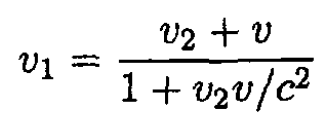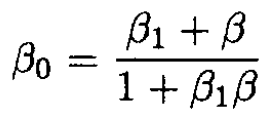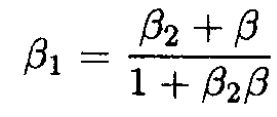


 الفيزياء الكلاسيكية
الفيزياء الكلاسيكية
 الكهربائية والمغناطيسية
الكهربائية والمغناطيسية
 علم البصريات
علم البصريات
 الفيزياء الحديثة
الفيزياء الحديثة
 النظرية النسبية
النظرية النسبية
 الفيزياء النووية
الفيزياء النووية
 فيزياء الحالة الصلبة
فيزياء الحالة الصلبة
 الليزر
الليزر
 علم الفلك
علم الفلك
 المجموعة الشمسية
المجموعة الشمسية
 الطاقة البديلة
الطاقة البديلة
 الفيزياء والعلوم الأخرى
الفيزياء والعلوم الأخرى
 مواضيع عامة في الفيزياء
مواضيع عامة في الفيزياء|
Read More
Date: 7-8-2016
Date: 29-8-2016
Date: 14-8-2016
|
Rapidity
a) Consider two successive Lorentz transformations of the three frames of reference K0, K1, K2. K1 moves parallel to the x axis of K0 with velocity v, as does K2 with respect to K1. Given an object moving in the x direction with velocity v2 in K2 derive the formula for the transformation of its velocity from K2 to K0.
b) Now consider n+1 frames moving with the same velocity v relative to one another (see Figure 1.1). Derive the formula for a Lorentz transformation from Kn to K0 if the velocity of the object in Kn is also v.

Figure 1.1
Hint: You may want to use the definition of rapidity or velocity parameter, tanh ψ = β, where β = v/c.
SOLUTION
a) The velocity of the particle moving in frame K1 with velocity v2 in the frame K1 is given by a standard formula:

Introducing βi = vi/c we may rewrite this formula in the form
 (1)
(1)
Now the same formula may be written for a transformation from K1 to K0:
 (2)
(2)
Now substituting (1) into (2), we obtain

b) If we need to make a transformation for n-frames, it is difficult to obtain a formula using the approach in (a). Instead, we use the idea of rapidity, ѱ. Indeed for one frame, we had in (1)

which is the formula for the tanh of a sum of arguments

where tanh ѱi = βi. This means that the consecutive Lorentz transformations are equivalent to adding rapidities. So the velocity in the frame K0 after n transformations (if vn+1 = v ) will be given by

We can check that if n → ∞, then βi → 1.



|
|
|
|
للعاملين في الليل.. حيلة صحية تجنبكم خطر هذا النوع من العمل
|
|
|
|
|
|
|
"ناسا" تحتفي برائد الفضاء السوفياتي يوري غاغارين
|
|
|
|
|
|
|
نحو شراكة وطنية متكاملة.. الأمين العام للعتبة الحسينية يبحث مع وكيل وزارة الخارجية آفاق التعاون المؤسسي
|
|
|